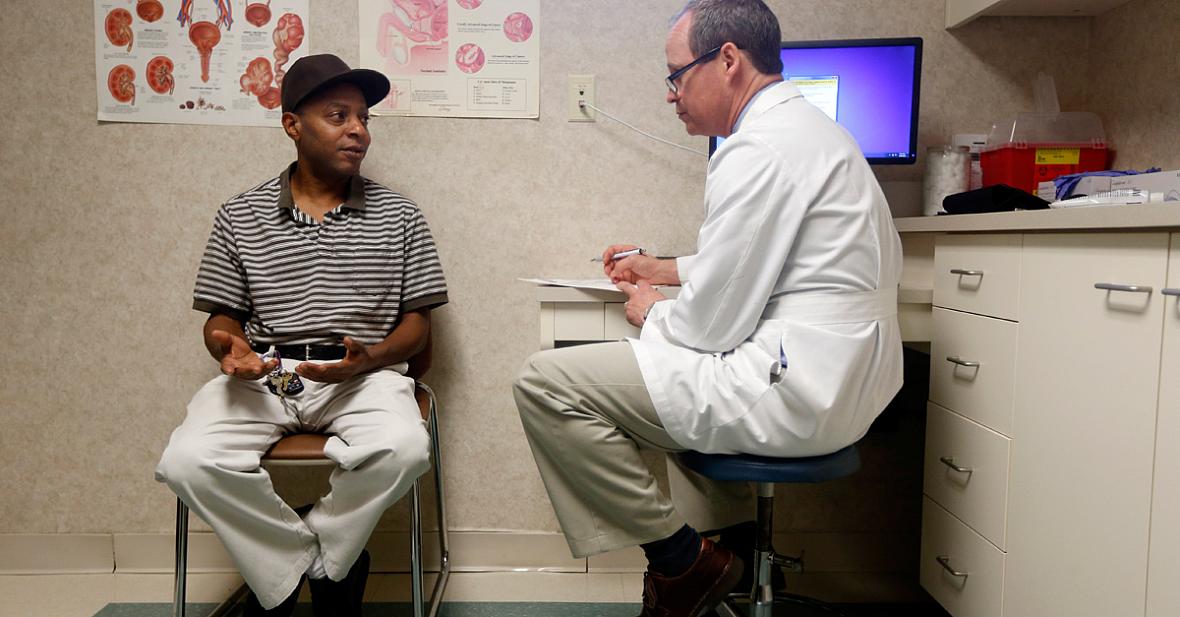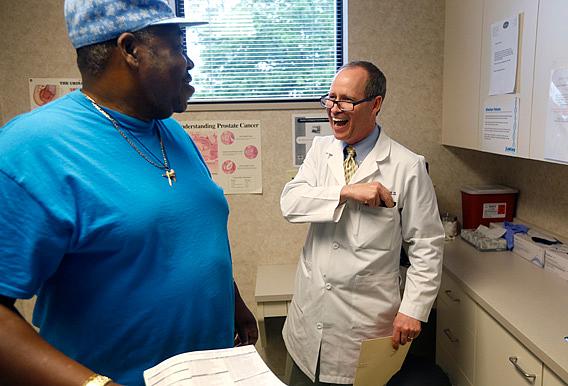Change in prostate cancer screening guidelines incites confusion
This series, originally published in The News & Observer, was produced with support from the Dennis A. Hunt Fund for Health Journalism, a program of the USC Annenberg School of Journalism's California Endowment Health Journalism Fellowships.
Other stories in this series include:
Prostate cancer attacks NC black men at startling rate
Duke expert: New prostate screening guidelines not accurate
UNC expert: Regular care is key to prostate cancer diagnosis
In poor, rural South, reaching black men at risk for prostate cancer is difficult
NC barber has 30 good reasons not to ignore prostate cancer symptoms
North Carolina state official: Funding to fight prostate cancer is tight

ETHAN HYMAN / ETHAN.HYMAN@NEWSOBSERVER.COM Dr. Greg Murphy talks with Jasper Barrett at Eastern Urological Associates in Greenville on Thursday, April 30, 2015. Barrett had prostate cancer.
Few things in modern medicine have been more controversial than federal guidelines for prostate cancer screening announced in 2011 by a panel of medical experts called the U.S. Preventive Services Task Force.
The recommendation itself was simple: Men, regardless of age, should not get the long-used blood test for prostate cancer.
The PSA test measures the level of a protein released by the prostate called prostate specific antigen. Elevated levels can signify the likelihood of tumors. It typically had been recommended by many doctors as a yearly test for men beginning at age 50.
But as a method for finding dangerous cancers, the test isn’t precise. It yields a high number of false positives: When men get prostate biopsies because of a high PSA level, only about 25 percent actually have prostate cancer, according to the National Cancer Institute. And there are also many false negatives, with men developing prostate cancer even though their PSA levels are low.
The test is usually performed in concert with a digital rectal exam, in which a doctor inserts his finger in a patient’s rectum to check the prostate for abnormalities, such as lumps. Sometimes one method helps find cancer when the other doesn’t.
Prostate cancer almost always emerges after age 50, and grows slowly. It’s the most common non-skin cancer in men. Many get it – about 16 percent of American men – but in most cases it’s not fatal or even dangerous.
The odds are significantly different, though, for black men, particularly in North Carolina, where they are almost twice as likely to develop it and nearly three times as likely to die of it.
Using large studies of Dr. Greg Murphy laughs with with patient Mickey Wooten. Murphy says he fears that not only are the recommendations against prostate screenings contributing to the deaths of black men, but white ones, too. Ethan Hyman / ethan.hyman@newsobserver.com
The report noted the higher risks for black men and said that there didn’t appear to be significant numbers of black men in the studies used to create the guidelines. But it also said that didn’t mean black men should get the PSA test.
“Thus, no firm conclusions can be made about the balance of benefits and harms of PSA-based screening in this population,” the guidelines state. “However, it is problematic to selectively recommend PSA-based screening for black men in the absence of data that support a more favorable balance of risks and benefits. A higher incidence of cancer will result in more diagnoses and treatments, but the increase may not be accompanied by a larger absolute reduction in mortality.”
FIGHTING THE GUIDELINES
The panel’s recommendations caused an instant uproar, with dissent coming in particular from urologists and oncologists.
By injecting confusion into the already difficult process of reaching black men with health information and preventive health care, the recommendations are inevitably contributing to deaths, some say.
Dr. Greg Murphy’s Greenville-based practice, Eastern Urological Associates, handles cases from many of the communities that are suffering from some of the widest racial disparities in prostate cancer in the nation.
“This is at least partly an educational issue, and one that we have just done an exceedingly poor job of reaching the people who we need to reach,” Murphy said. “And the message is confusing that we need to reach them with because now we in medicine have a disagreement whether this is important to do or not. Those of us who treat prostate cancer and see people die of prostate cancer think screening is important.”
After the recommendations, other national groups, including the American Urological Society and the American Society for Clinical Oncology, modified their own guidelines. Generally, such groups now say that men should make decisions about screening after a discussion with their doctor about the risks and benefits and that those at high risk should consider regular screening.
The American Cancer Society began recommending that at age 50, men who are expected to live at least 10 more years talk with a health care provider about whether to be screened. For African-American men and for men with a direct relative who developed the disease before age 65, it says that talk should come at age 45. For those with more than one close relative who was diagnosed at an early age, the conversation about screening should happen at age 40.
“Our recommendation is really about men arming themselves with information so that they can make an informed decision,” said Dr. Durado Brooks, director of prostate and colorectal cancers for the American Cancer Society.
CONTRIBUTING TO DEATHS?
Many, particularly those who treat prostate cancer patients, remain upset about the guidelines.
Murphy, the Greenville urologist, said he fears that not only are the recommendations contributing to the deaths of black men, but white ones, too, by ensuring that more cancers will be caught only in late stages, when they are much more deadly.
The panel’s guidelines, he said, focused too much on overdiagnosis. They were right that there was too much treatment, he said, but that has been reduced, at least in part by an emphasis on simply watching to see if the disease shows signs of worsening, rather than making treatment the default.
Many experts say that even if the guidelines aren’t useful for helping black men make decisions on screening, it is not wise to swing back to flatly telling them to get screened. Such an important recommendation should be based on proper studies of black patients, they say.

